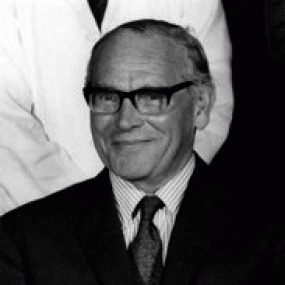Obituary - Dr Arthur Ivor Parry Brown

1908 to 2007
Dr Parry Brown, always known to friends and senior colleagues, simply as “Parry” died in Cambridge in November 2007 aged 99 years. He had worked at the London Hospital from 1933 to 1973 and as a young man also worked the National Heart and the Brompton Hospitals.
He was recognised as a versatile and pioneering anaesthetist during his career. He was always very calm in the operating theatre and his surgical colleagues relied heavily on his expertise and judgment. He was very well liked and is remembered very fondly by all those he worked with but under the polite exterior lurked an inner steel. He liked to do things his way and woe betide a trainee who displeased him by some maverick variation on his technique. For instance he particularly disliked the use of carbon dioxide to stimulate breathing at the end of an anaesthetic and its unauthorised use would induce a polite but personally devastating rebuke.
At the beginning of his career anaesthesia was still practised with ether and a Schimmelbusch mask and Parry was still able to demonstrate this technique at his last anaesthetic before his retirement in 1973. He is also remembered as an exponent of induction of anaesthesia with a rectal infusion of Bromethol. This technique, which seems perversely eccentric to us today, almost achieved the status of a religious ceremony as the Bromethol was brought to theatre in and administered through a tube from a silver canister. Parry believed strongly that it was the safest induction for patients with thyrotoxicosis undergoing thyroidectomy. Parry also maintained anaesthesia for thyroidectomies was by holding on an especially adapted mask with the patient breathing spontaneously. This technique was particularly stressful for a trainee with small hands.
His main interest was thoracic anaesthesia and the bulk of his career was before the advent of cardio-pulmonary bypass. He worked with Mr Vernon Thompson (Thompson bronchus blocker) and Mr Geoffrey Flavell at the London and Sir Thomas Holmes Sellors at the Brompton. At that time one-lung anaesthesia was achieved by the use of the fearsome Carlen tube of which he was a master. Parry believed in the “educated hand “for thoracic anaesthesia and at that time ventilators in theatre were in short supply. Monitoring even into the mid 1960s consisted of a blood pressure cuff or oscillotonometer and Parry always had a finger on the temporal pulse. For a long time there was only one ECG monitor in the London Hospital theatres and whether you used it depended on how early you arrived in the morning.
Parry was most famous for the Parry Brown “prone” position used for patients having pulmonary resections first described in Thorax (1) in 1948. (See picture) This allowed drainage of excessive secretions particularly with bronchiectasis and tuberculosis. The position prevented spill over of secretions to the contra lateral lung and depended the surgeon being familiar with a posterior approach to the thorax. The only disadvantage ascribed to this position was the sudden cardio vascular collapse that occurred in some patients with limited cardiovascular reserve when they were turned face down. (No saturation probe, no arterial line, no ECG, a finger on the pulse and hand ventilation!).
The patient lies prone with flexed hips and pillows under the chest and pelvis, allowing the abdomen to hang free. The ipsilateral arm hangs over the edge of the operating table (drawing the scapula away from the incision site) with the contralateral arm lying at the side. The head is extended on the atlanto- occipital joint and rotated to the ipsilateral side – this straightens the line of the trachea and contralateral bronchus. When the operating table is tilted, secretions will gravitate along the tracheal tube to the mouth and can be easily suctioned – this is in direct contrast to the Overholt position where secretions tended to remain in the lung until the bronchus was divided. This position had the advantages of continual drainage of the lungs, together with greater mediastinal stability, albeit at the expense of a more limited incision as compared to a lateral thoracotomy. It represented a significant advance in thoracic anaesthesia, (described initially of course with a single lumen tube).
Cardio-thoracic anaesthesia has come a long way since then but it is well to pause occasionally and remember men like Parry Brown who had the skills and clinical acumen to develop the techniques that have eventually led to where we are today. At the same time we should also remember the patients who had the courage to subject themselves to anaesthesia and surgery at a time when both were so hazardous.
(1) Parry Brown, A.I. Posture in Thoracic Surgery. Thorax, 3:161-5 (1948)
Kate Wark
(with thanks to Jerome Cotter, Peter Colvin and John Simpson)
